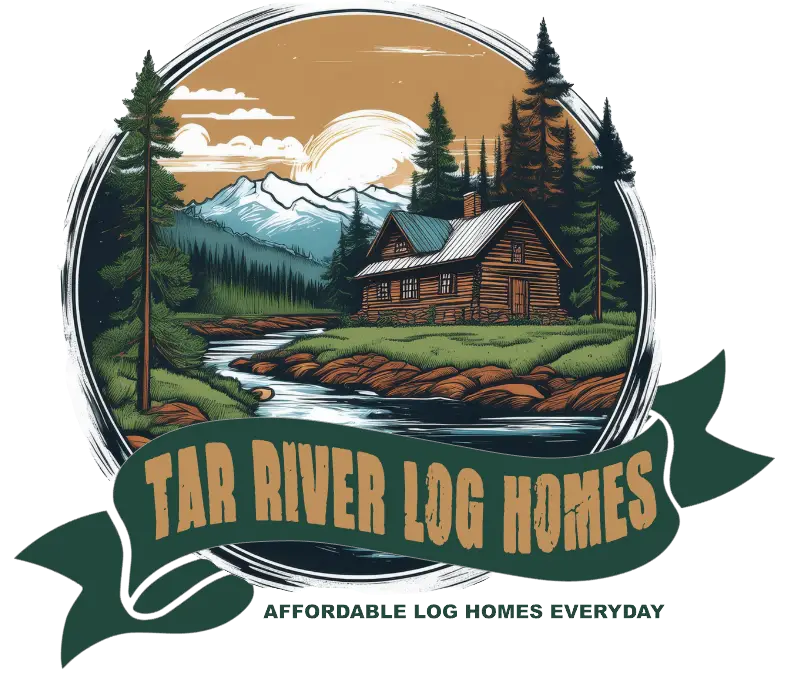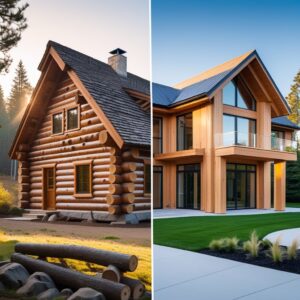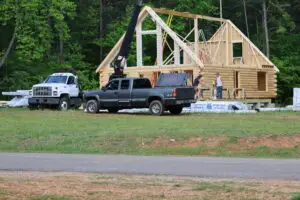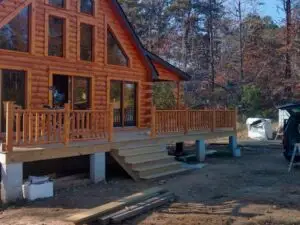If you’re weighing your options for a wood home, you’ve likely heard of both log homes and timber homes. At first glance, they seem similar, but the way they’re built—and how they perform—are quite different.
A log home uses full logs stacked to form walls, while a timber home relies on squared beams for its frame. These differences affect everything from cost to insulation, maintenance, and even the look of your home.
At Tar River Log Homes, we believe families deserve clear answers and affordable building options. That’s why we focus on sturdy log home kits that make sense for real budgets.
This guide breaks down the key differences between log and timber homes—so you can choose the style that fits your lifestyle, wallet, and long-term plans.
What Are Log Homes?
Log homes use thick logs stacked horizontally to form the walls. These homes offer natural insulation and a solid structure. You’ll see a range of styles and construction methods, which change the look and performance.
Defining Log Homes
Log homes are built almost entirely from whole logs. The logs fit tightly together, keeping out wind and rain. Sometimes the logs are round, sometimes shaped, but you always see the wood’s texture.
You get a classic cabin vibe with a log home. The logs aren’t just for show—they hold up the roof and form the walls. People love them for their rustic charm and the cozy, natural feel.
Traditional Construction Methods
Builders stack hand-crafted or machine-cut logs horizontally, joining them at the corners with notches. This makes a tight, stable fit that stands up to time.
Between the logs, builders use chinking or caulking to seal gaps. This keeps the home insulated and dry. Thicker logs mean better energy savings, but building can take a bit longer.
Types of Log Profiles
Common log profiles include:
- Round Logs: Keep their natural rounded shape for a rugged look.
- D-Logs: Flat inside, round outside, so the interior walls are smoother.
- Square Logs: Milled into squares for tight fits and even walls.
Each profile changes the style and how easy it is to finish inside. Our team can cut logs to match your design.
What Are Timber Homes?
Timber homes use large wood components, but they’re not the same as traditional log homes. Instead of stacking round logs, timber homes use squared or rectangular beams joined together. You’ll see strong frames and stylish wood details inside.
Characteristics of Timber Homes
Timber homes rely on heavy timber posts and beams. The wood usually stays exposed inside, showing off the grain and knots. Unlike full log walls, these homes have insulation and standard siding or paneling.
Timber frames support bigger open spaces, so you get flexible design options. You’ll get a sturdy build and warm wood accents. These homes often have better energy efficiency since the walls aren’t solid logs.
Timber Frame Construction
Builders create a skeletal frame with thick timber beams, connecting them at joints using wooden pegs or metal fasteners. This framework supports the roof, floors, and walls.
Once the frame stands, non-structural walls go up—maybe drywall, stone, or wood siding. Timber frames allow for high ceilings and big windows, giving the home both strength and character.
Exposed Beam Designs
A standout feature is the exposed timber beams inside. You’ll spot beams crossing ceilings, framing doorways, or holding up lofts. It adds a rustic, inviting look.
The exposed beams are decorative and structural. They show off the craftsmanship. Many builders include these beams to keep that honest, hardworking feel without extra cost.
Primary Differences Between Log and Timber Homes
Log and timber homes might look alike at first, but they’re built and finished differently. How the wood is cut, shaped, and assembled changes the strength and appearance. The homes also use different wood types and construction methods.
Construction Techniques
Log homes stack whole logs horizontally, notched at the corners for a tight fit. The stacked logs make up the walls and roof structure. Logs are peeled and sometimes hand-fitted, which takes more time but gives a solid, natural feel.
Timber homes use large squared beams joined with metal fasteners or wooden pegs, forming a frame. Other materials fill the spaces between. This allows open interiors and quicker builds, but requires extra insulation.
Log homes work well if you want a rustic, straightforward build. Timber homes suit bigger, modern layouts with open rooms.
Aesthetic Appeal
Log homes give you that classic, rugged look with visible, rounded logs inside and out. The natural wood grain and curves create a warm, cozy mood—almost like living in a wooden cabin.
Timber homes show off thick, squared beams in the walls and ceilings. The beams create bold lines and sharp edges. This style fits both modern and rustic tastes, but feels more structured than log homes.
Choosing comes down to whether you want simple rustic charm or a bold wood frame look.
Materials Used
Log homes mostly use solid logs, often Eastern White Pine or cedar. These woods resist bugs and weather. The logs keep their full shape, which preserves strength and natural insulation.
Timber homes use large, milled beams cut into posts and beams. The wood gets dried and squared for a precise fit. You’ll see pine or Douglas fir, both known for strength and straight grain.
We focus on Eastern White Pine logs, perfect for sturdy, affordable log homes. You pick the materials, and we deliver quality wood—no extra fees or markups.
Building Process and Structural Design
When you build a log or timber home, how the parts connect, insulation, and customization all matter. These details affect how strong and comfortable your home will be.
Joinery Methods
Logs and timbers come together with different joinery styles. Log homes use saddle notch or chinked joints to fit logs snugly and lock them in place, keeping drafts out. Timber homes use post-and-beam construction—big beams connect with metal fasteners or wooden pegs, allowing for wide open spaces.
Joinery affects how your home handles weather and settling. Log homes rely on tight notches to keep out gaps, while timber frames count on heavy beams for strength. Both need careful building to stay strong and prevent air leaks.
Insulation and Energy Efficiency
Log walls store heat during the day and release it slowly, which helps with warmth. Still, logs alone may not insulate enough in cold places. Timber homes usually have framed walls with room for modern insulation like foam or fiberglass, which often works better in harsh weather.
To keep energy bills down, seal corners and windows well. We use kiln-dried logs that shrink less and insulate better. Adding insulation or choosing efficient windows will boost comfort in either home.
Energy Performance in Log vs. Timber Homes
Log homes rely on the thermal mass of thick wood walls. This means they absorb heat during the day and release it slowly at night. While this helps regulate temperature swings, logs alone don’t always meet modern insulation standards. Sealing gaps and corners is critical.
Timber homes, by contrast, use framed walls that leave room for modern insulation like spray foam or fiberglass. According to the U.S. Department of Energy, proper insulation in timber homes can achieve higher R-values than log walls, which makes a difference in colder climates.
Customization Options
Both log and timber homes let you pick sizes, shapes, and styles, but timber homes usually offer more flexibility in floor plans. Timber frames can support big open rooms and tall ceilings without extra walls, making layout changes easier.
With log homes, each log is part of the wall, so changes are trickier and need planning before cutting. You can choose log thickness, wood style, and the overall look. Whether you want a simple cabin or a detailed lodge, you can still customize to fit your taste and budget.
Maintenance and Longevity
Knowing what it takes to care for your home and how long it’ll last helps you plan. Log and timber homes need different upkeep and react to weather in their own ways. Durability depends a lot on materials and how well you look after things.
Upkeep Requirements
Log homes need regular checks for cracks, bugs, and moisture. You’ll probably stain or seal the logs every 3 to 5 years. This protects the wood from water and sun, preventing rot or fading.
Timber homes use milled beams and framed walls covered by siding or panels. They usually need less sealing, but you might need to paint or repair siding. Insulation and ventilation checks matter for both, but timber walls are often easier to update.
Weather Resistance
Logs can handle wind and cold if you keep them sealed. They insulate well, but if the finish wears off, they’ll soak up moisture. Keeping your log home sealed stops swelling and warping.
Timber homes use engineered materials or framing that handle rain differently. They depend on siding or cladding for protection, so check for cracks, peeling paint, or gaps that let water in. Good flashing around windows and doors helps prevent leaks.
Durability Over Time
Logs can last decades—sometimes over a hundred years—if you keep up with maintenance. Problems usually come from neglect, like skipping stain jobs or ignoring cracks. With care, a log home stays strong and good-looking.
Timber homes depend on the wood type and construction. They resist pests and weather well if the exterior stays in shape. Repairs are usually simpler since walls aren’t solid logs. Both can last a lifetime with good upkeep.
We’re proud to offer quality logs that make maintenance easier and more affordable. Your investment in solid materials pays off.
Cost Considerations
Planning your log or timber home? Understanding costs makes a big difference. You’ll want to know what it takes to build and what value you’ll get over time.
Initial Construction Costs
Log homes often use solid, round logs that take more time and work to prepare. That can mean higher upfront costs. Timber homes use squared or milled wood, which stacks and finishes faster—usually lowering building costs.
Other things affect cost too: wood type, home size, and how much you want to customize. Our kiln-dried logs are ready, which saves time and cuts waste. You pay for quality materials without big markups. Simple designs cost less, while unique styles add to your budget.
Long-Term Value
Log homes hold value because they’re sturdy and can last for decades if you keep up with care. Over time, a solid log home might save money on repairs compared to timber homes with thinner walls. Timber homes can be more energy-efficient with better insulation, lowering heating bills.
Maintenance matters. Logs need regular sealing to avoid rot or pests, while timber structures might need less upkeep. Pick what fits your lifestyle and how much time or money you want to spend on care.
With the right supplier, you get strong materials and honest pricing—designed to fit your budget now and later.
Lifestyle and Environmental Impact
Choosing log or timber homes changes your daily life and affects the environment. It also shapes your home’s value and how easy it is to sell. These things matter when deciding what’s right for you.
Living Experience
Log homes give a cozy, natural vibe. Thick logs help keep things warm in winter and cool in summer, which can lower energy bills.
Timber homes feel more modern, with exposed beams and open spaces. They’re usually brighter inside, with more room for windows and design choices.
Both types connect you to nature, but log homes are often quieter since the logs absorb sound. Timber homes might need extra insulation for the same quiet.
Sustainability Factors
Log homes use whole logs, often from sustainable forests, meaning fewer processed materials and less waste. If managed well, log harvesting is renewable. Timber homes rely on milled wood and manufactured panels. They might include recycled materials, but they can take more energy to produce.
Both homes store carbon in the wood, helping reduce greenhouse gases. Your choice depends on how the wood is sourced and treated. A trusted company uses materials from managed forests, keeping the environmental impact low while offering sturdy builds.
Resale Value
Log homes usually hold their value thanks to their unique style and sturdy build. Buyers are often drawn to that rustic charm and natural vibe. Timber homes, on the other hand, tend to pull in folks who prefer a modern look or want bigger windows. Their resale value really comes down to the finish and layout.
Maintenance matters for both. With a log home, you’ll need to seal it up regularly to keep the weather out. Timber homes can need some attention too—think siding and beam upkeep. If you’re looking for a home that keeps its value without draining your wallet, a log home might be just what you need. They manage to balance quality with affordability, which is honestly pretty rare these days.
Choosing Between Log and Timber Homes
So, you’re torn between a log home and a timber home? It really comes down to your taste and budget. Log homes use whole logs stacked up, which gives them that cozy, old-school feel. They actually tend to feel warmer, too, since the logs naturally store and release heat.
Timber homes go with big wooden beams and posts, usually spaced out more, so the rooms feel open. You can mix in stone or glass without it looking out of place. Plus, since a lot of the parts come pre-cut, timber frames can go up faster.
Here’s a quick side-by-side:
| Feature | Log Homes | Timber Homes |
| Look | Rustic, solid wood walls | Open beams, spacious feel |
| Insulation | Natural thermal mass | Depends on infill materials |
| Build Speed | Slower, more manual labor | Faster with prefab parts |
| Customization | Traditional designs | Flexible with styles |
A trusted company focuses on affordable log home kits that still deliver on quality. You get straightforward pricing and some help picking out what works for you. If you’re after something classic and energy-smart, a log home could be your best bet. For a more modern spin with wood, timber frames are a solid choice.
No matter what you go for, you’ll want decent materials and a plan that actually fits your life. You choose the look, they’ll handle the logs or beams—no nonsense, no sneaky fees.
Making the Right Choice for Your Wood Home
Both log and timber homes have their strengths. Log homes bring rustic charm, natural insulation, and solid durability. Timber homes offer more flexibility in layouts and often feature dramatic, open interiors.
The right choice depends on your lifestyle, budget, and what you value most in a home. At Tar River Log Homes, we keep things simple—affordable, quality log home kits with no hidden costs.
If you’re ready to explore your options, reach out today, and let’s start planning your dream cabin together.
Frequently Asked Questions
Log homes and timber homes aren’t the same—they differ in style, how you build them, how much work they need, and how they stand up to the weather. Knowing the basics helps you figure out what suits you.
What are the visual distinctions between log homes and timber homes?
Log homes use whole logs stacked horizontally, so you see those round or squared-off log faces. Timber homes are all about those big beams joined together, with the frame often showing inside.
Log homes look sturdy and rustic. Timber homes show off more architectural flair, with visible joints and open spaces.
How do the construction methods of log and timber homes differ?
You build log homes by stacking logs and sealing up the gaps, working layer by layer. Here’s a look at that process. Timber homes use heavy beams hooked together with joinery or metal bits, creating a frame that holds everything up.
What are the maintenance considerations for log versus timber homes?
Log homes need you to check for cracks, bugs, and keep up with sealing so you don’t get air leaks. Timber homes don’t usually need sealing as often, but you’ll want to keep an eye on the joints and beams for moisture or pests.
Are there specific climate considerations when choosing between log and timber homes?
Log homes do great in cold places since the thick logs hold heat. Timber homes give you more wiggle room for insulation and ventilation, which helps if your climate swings between hot and cold.
What factors affect the durability and longevity of log and timber homes?
Good wood and proper treatment make both types last longer.
Staying on top of sealing, pest control, and moisture is what really keeps these homes standing strong.
Can you provide a comparison of energy efficiency between log and timber homes?
Log homes tend to hold heat well because those thick logs act like a natural insulator — especially handy when winter hits and you’re watching the heating bill. Timber homes can match that efficiency, but only if you really pay attention to insulating the walls and roof right from the start.For affordable options that don’t skimp on quality, Tar River Log Homes has some designs that strike a nice balance.




